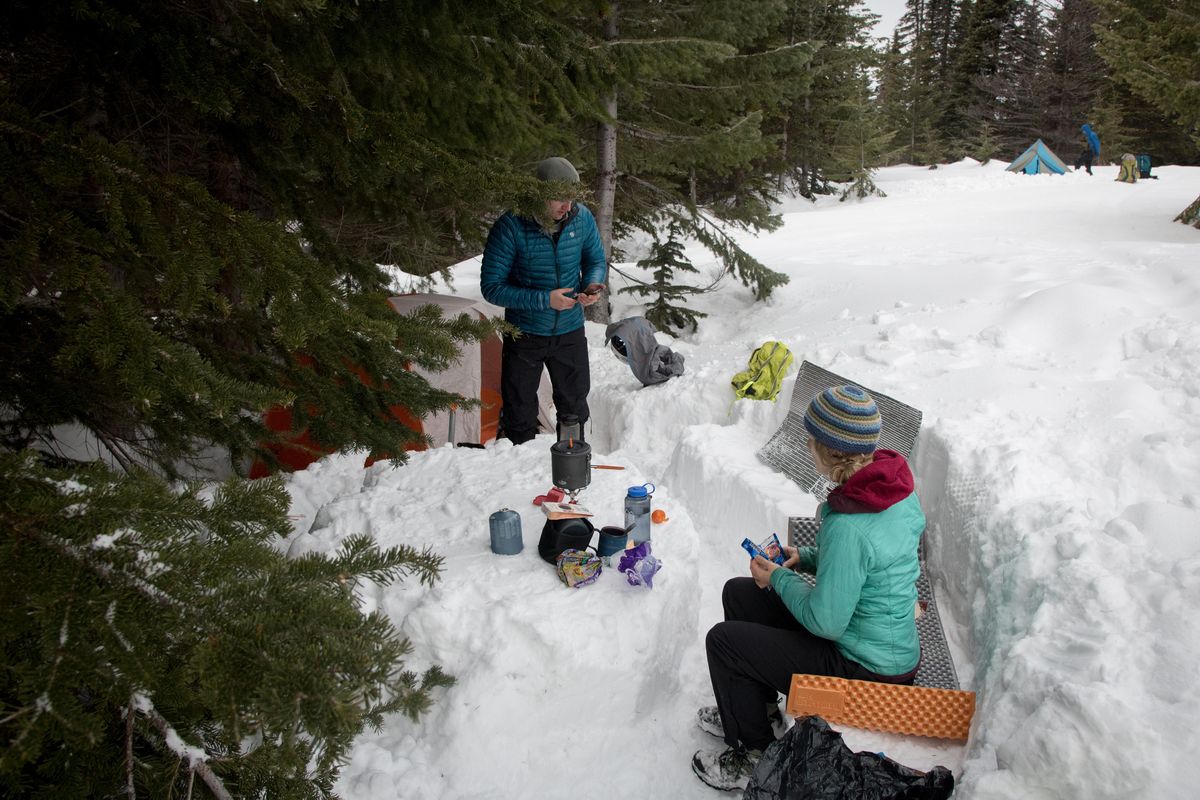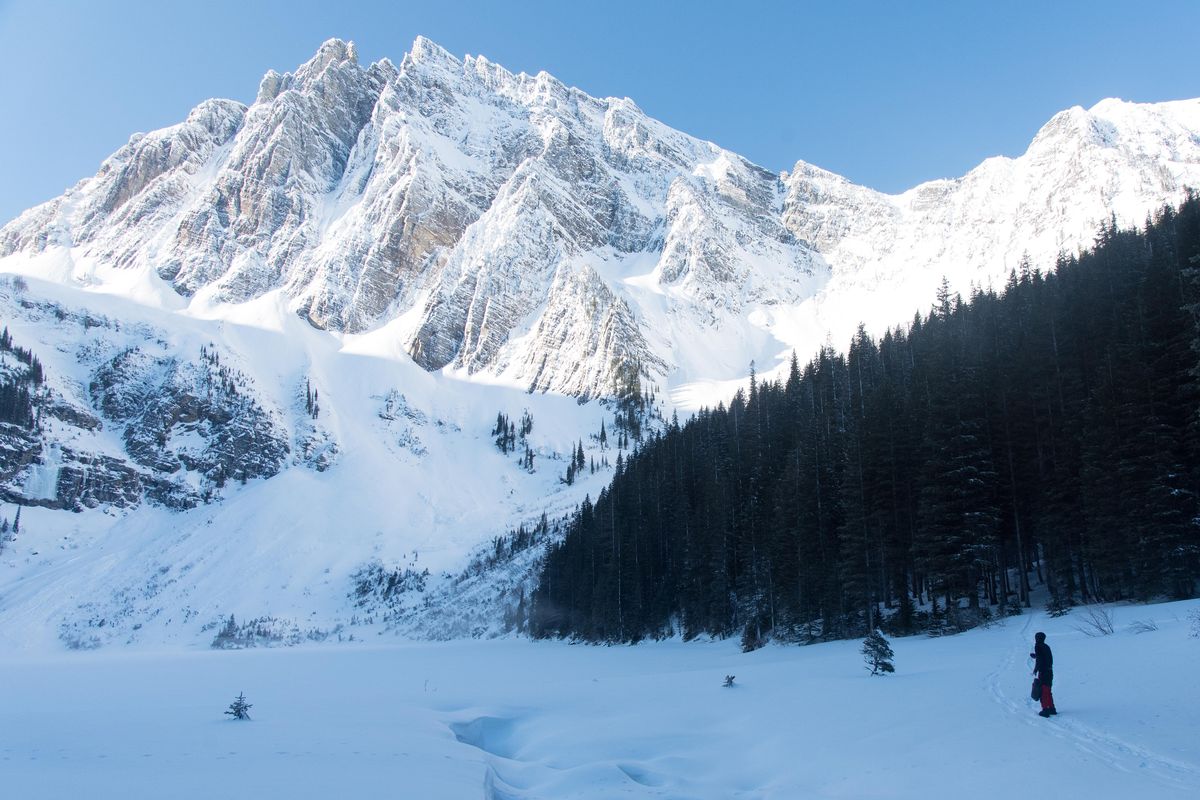Snow camping, not as bad as it sounds
Will Holmquist, left, and Carolyn Cartwright sit in the "kitchen" they built while snow camping in March 2018 with the Spokane Mountaineers. (Eli Francovich / The Spokesman-Review)Buy a print of this photo
Snow camping is the perfect way to treat yo self.
I’m serious. It’s the best-kept secret in the outdoor world and I’m blowing the lid off in service to you, dear reader.
Don’t believe me?
Let me explain.
During the warmer summer months, backpacking is, for many, an exercise in austerity. Outdoor brands stake their reputations and business on cutting ounces. Hikers are encouraged to buy freeze-dried “food” and pack the barest of essentials. Ultralight, hyperlight, uber light and extra extra uber ultralight are adjectives tossed around with abandon. True quality is measured, it would seem, in gossamer.
It’s an exhausting cycle that, I fear, leads to only one thing: hiking naked and alone through the woods carrying only a freeze-dried cliff bar and a 2-ounce life straw bouncing around your neck (a lighter, more functional version of an albatross) while your Vibram shoes slowly disintegrate.
Which is why winter camping is so great. Gone are the admonishments to cut weight. No! In the winter, it’s all about bulking.
Bring that extra puffy jacket. Grab that uber thick sleeping pad. Only have one pair of pants? Why not take two. Oh, and don’t forget a stick of butter and some whiskey.
Sure, you might not go all that far, but you’re winter camping. You don’t need, and aren’t expected, to cover much ground.
If you say you’re going camping in the summer, someone will invariably ask, likely in a high-pitched squeal, “How far did you go and how much did your pack weigh?” That won’t happen in the winter. Instead, they’ll look at you, shocked and impressed by your rawness.
Plus, ho-hum destinations, places you might not think twice about visiting in the summer, suddenly become snow-blanketed wilderness with all the associated mystery and adventure. It’s also a key skill for back country skiers or alpine climbers.
Like I said, it’s the best-kept secret out there. So here are some basic tips and tricks to get you camping this winter.
Start small
Despite my flippant tone, winter camping, and winter travel in general, do come with increased risk. While you don’t have to worry about bugs or heatstroke, you do have to worry about avalanches and hypothermia. If you’re heading out for the first time, stay close and stay safe. Pick an easily accessed spot with no avalanche danger. Suggestions? Riverside State Park’s Bowl and Pitcher campground is a drive-up camping spot that allows you to bring the kitchen sink and more. Plus, it offers great snowshoeing and a scenic camping spot along the Spokane River. To reserve a spot, visit parks.state.wa.us/223/Reservations.
Other good options include the Colville National Forest and the Idaho Panhandle National Forest. Check road conditions before going.
Pack big
Don’t skimp on the clothes and gear, especially as a newbie winter camper. The best way to make winter camping an enjoyable experience is to pack and dress correctly. That includes a good sleeping bag, wool socks, fleece pants, warm base layers, a puffy coat and waterproof or resistant shells. Staying dry is key when snow camping, both for comfort and safety. Bring extra clothes you can wear while hanging out in camp.
Your sleeping setup is key. While a warm sleeping bag is important, don’t forget about the sleeping pad. The quickest way to get cold is not having good insulation between you and the ground. The folks at Mountain Gear or REI can get you started with the right gear.
That being said, don’t get sucked into the gear trap. You can go winter camping without having all the state-of-the-art gear. Your summer tent can work as a winter tent, for instance. Sure, it won’t be as wind- or water-resistant but if you keep your objective small, it can work. I’ve spent several nights in the winter back country using my normal backpacking tent. A sleeping pad and bag are far more important than a tent for retaining heat.
Make a good camp
First, pick a safe campsite. If you’re in avalanche terrain, make sure you’re camping in a safe spot. Find a spot that’s protected from the wind and far from any other hazards, such as dead or leaning trees.
Pack down the snow. Use a shovel, skis or your boots to pack down the snow where you’ll pitch your tent. Take the additional time to create a kitchen and a sitting area. Use a shovel to create seats and tables for cooking and eating. This might seem unnecessary, but it’s well worth the effort. The actual work will keep you warm and pass the time, and later you’ll enjoy having a place to sit and relax.
A note on sitting: Bring some sort of pad. Stores sell insulated sitting pads. You can also use a backpack in a pinch. Zack Turner, an alpine climber and climbing instructor at Eastern Washington University, emphasizes the importance of having a good shovel with an extendable handle and staying positive.
“Adjust your expectations to embrace the cold, bring games (or whiskey) for when it gets dark early,” he said.
Eat right
Eat, drink and be warm. Drink lots of water, tea or other warm liquids. It’s easy to get dehydrated when recreating in the cold, so be disciplined about your fluids.
Don’t skimp on snacking and meals. Eat fatty, warm and rich foods. I personally love adding some butter to my coffee or hot chocolate. Another benefit of winter camping? Foods like meat and cheese won’t spoil, so bust out the charcuterie board.
“Sometimes if I’m in the back country, I live on dried meat and trail mix for days, but for snow camping I like hot porridge, stews, soups, chili, dal (mmmm memories of Nepal!), and always a thermos of hot tea,” said Ammi Midstokke, a frequent winter adventurer and SR columnist.
Sleep tight
When you bed down, put on clean and dry clothes. Stuff your daytime clothes into your sleeping bag. If they’re damp or wet, that will help dry them out. Plus, it gives you another layer of insulation. Midstokke also recommends bringing plenty of toe and foot warmers.
“They can be so nice on the toes in a sleeping bag,” she said.
Another option? Put boiling water in your water bottle and sleep with your bottle at your feet. This is Turner’s “favorite sleeping trick.”

